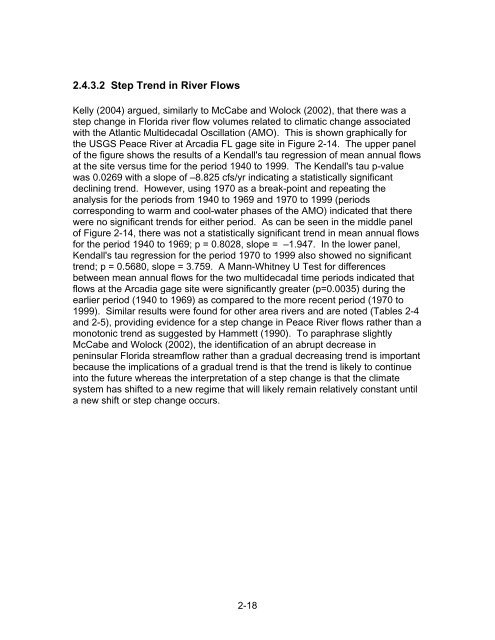Chapter 1 Minimum Flows and Levels - Southwest Florida Water ...
Chapter 1 Minimum Flows and Levels - Southwest Florida Water ...
Chapter 1 Minimum Flows and Levels - Southwest Florida Water ...
You also want an ePaper? Increase the reach of your titles
YUMPU automatically turns print PDFs into web optimized ePapers that Google loves.
2.4.3.2 Step Trend in River <strong>Flows</strong><br />
Kelly (2004) argued, similarly to McCabe <strong>and</strong> Wolock (2002), that there was a<br />
step change in <strong>Florida</strong> river flow volumes related to climatic change associated<br />
with the Atlantic Multidecadal Oscillation (AMO). This is shown graphically for<br />
the USGS Peace River at Arcadia FL gage site in Figure 2-14. The upper panel<br />
of the figure shows the results of a Kendall's tau regression of mean annual flows<br />
at the site versus time for the period 1940 to 1999. The Kendall's tau p-value<br />
was 0.0269 with a slope of –8.825 cfs/yr indicating a statistically significant<br />
declining trend. However, using 1970 as a break-point <strong>and</strong> repeating the<br />
analysis for the periods from 1940 to 1969 <strong>and</strong> 1970 to 1999 (periods<br />
corresponding to warm <strong>and</strong> cool-water phases of the AMO) indicated that there<br />
were no significant trends for either period. As can be seen in the middle panel<br />
of Figure 2-14, there was not a statistically significant trend in mean annual flows<br />
for the period 1940 to 1969; p = 0.8028, slope = –1.947. In the lower panel,<br />
Kendall's tau regression for the period 1970 to 1999 also showed no significant<br />
trend; p = 0.5680, slope = 3.759. A Mann-Whitney U Test for differences<br />
between mean annual flows for the two multidecadal time periods indicated that<br />
flows at the Arcadia gage site were significantly greater (p=0.0035) during the<br />
earlier period (1940 to 1969) as compared to the more recent period (1970 to<br />
1999). Similar results were found for other area rivers <strong>and</strong> are noted (Tables 2-4<br />
<strong>and</strong> 2-5), providing evidence for a step change in Peace River flows rather than a<br />
monotonic trend as suggested by Hammett (1990). To paraphrase slightly<br />
McCabe <strong>and</strong> Wolock (2002), the identification of an abrupt decrease in<br />
peninsular <strong>Florida</strong> streamflow rather than a gradual decreasing trend is important<br />
because the implications of a gradual trend is that the trend is likely to continue<br />
into the future whereas the interpretation of a step change is that the climate<br />
system has shifted to a new regime that will likely remain relatively constant until<br />
a new shift or step change occurs.<br />
2-18
















